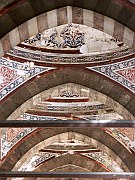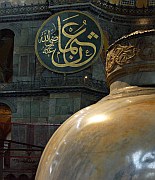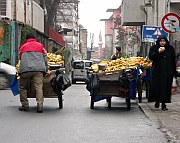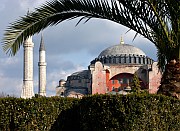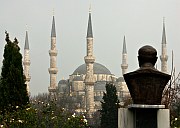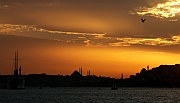This website is an archive from 2016
This site was actively maintained from 2006 to 2016. Since then I have kept it online for historical interest, but have made no further updates. Much of the information in these pages is now incorrect or obsolete.
European Turkey | Introduction
Istanbul is right at the edge of Europe, but right at the heart of Balkan history. Few cities have been so important for so long, and modern Istanbul is richly endowed with monuments to its imperial past. It can be a slightly melancholy place - those same monuments are a reminder that the city's multilingual, multiethnic mixture of peoples failed to survive the twentieth century. The capital of two empires is no longer even the capital of a country, the city of the Sultans having been usurped by Ankara, a city of civil servants. But that hasn't made Istanbul an irrelevance - far from becoming a museum town, it just keeps on growing. Anyone who likes cities will love Istanbul.
Where to go: some suggestions
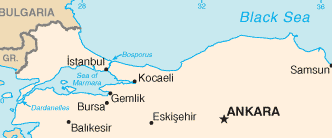

Most visitors head straight to Sultanahmet, where some of the city's major monuments are conveniently grouped together. As you stand between Haghia Sophia and the Blue Mosque in Sultanahmet Square, it's hard to grasp the immense span of time represented here - well over a thousand years separate the construction of those two structures. Along with the Topkapı Palace and the Grand Bazaar they form the Big Four of Istanbul tourist attractions, none of which need any further description from me. Impressive as these monuments are, Sultanahmet is not really representative of the city as a whole - at times it feels like everyone there is either a tourist or selling something to tourists. The real joy of Istanbul is exploring its other districts, in which locals vastly outnumber foreign visitors.
One way to get a feel for the city's history is by walking along the southern shore of the Golden Horn from Galata Bridge, with occasional detours into the streets of the Fener and Balat neighbourhoods. Look out for the cast-iron Bulgarian Church and the imposing red-brick Greek School for Boys, and see if you can find the modest headquarters of the Patriarch of Constantinople. When you reach the Land Wall, consider how long it has taken you to get there - that's how big the city was when the walls were built in the fifth century. Continuing alongside the water will take you to Eyüp, one of my favourite parts of Istanbul. After visiting the mosque, an important pilgrimage centre, walk uphill through the cemetery to enjoy views along the whole of the Golden Horn.
An equally interesting urban hike, parallel to the one I've just described, follows the crest of the low hills that overlook the Golden Horn and zigzags between some of the most impressive mosque complexes in Istanbul (and the world). If you only visit one mosque in Istanbul it should be Süleymaniye, perhaps the most successful Ottoman attempt to build a structure as awe-inspiring as Haghia Sophia. Fatih Mosque, more bulky than beautiful, is at the heart of one of city's more conservative neighbourhoods. The terrace of the Selimiye Mosque is a wonderful place to have a rest and take in the panoramic view of the city. This walk could be extended almost as far as Land Wall to visit the Church of Saviour in Chora, whose frescos are a must-see for anyone interested in Byzantine art.
There is of course much more to Istanbul than history. North of the Horn the Galata and Beyoğlu districts are at the commercial heart of modern Istanbul. If you need some fresh air, don't look for a park - there are hardly any in this city. Instead head for the waters of the Bosphorus. Hop on a ferry to the Asian shore to appreciate the iconic Sultanahmet skyline, ideally around sunset. Or take the Bosphorus Cruise past palaces and mediaeval castles to the increasingly rural shores near the Black Sea.
The rest of European Turkey is overshadowed by Istanbul, but the city of Edirne has yet more impressive mosques and may be worth a stop on the way to Greece or Bulgaria. The Princes' Islands in the Sea of Marmara are a popular excursion from Istanbul, and many people visit the Gallipoli Peninsula to see the First World War battlefields.
Practicalities
Sirkeci Station is conveniently located in central Istanbul, near the Galata Bridge. It is no longer the terminus of the Orient Express, but you can still catch a train to Bulgaria, Romania, Greece, or Serbia.
The international bus terminal in the Esenler suburb of Istanbul has connections to a wide range of places in the Balkans. Depending on the destination they are quite likely to get you there faster than the train, although this depends on traffic levels at border crossings. Domestic buses to other parts of European Turkey also leave from here. Even in the case of places with a train service such as Edirne, travelling by bus is likely to be much faster.
If you are travelling onwards into Asian Turkey, you can get a bus to just about anywhere. The better companies operate very comfortable coaches. The train network is much more limited, but don't rule out train travel completely - some services are very comfortable and sleeper accommodation is very good value. Besides, there are few more evocative ways to begin a journey than by taking a ferry across the Bosphorus to Hydarpaşa Station on the Asian shore.
